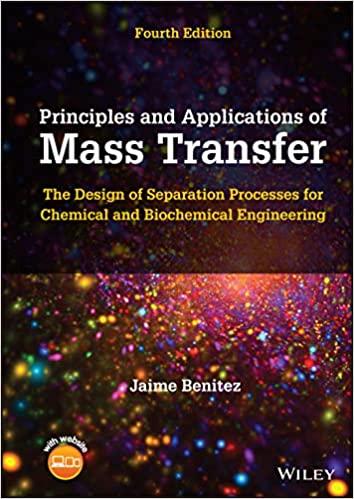Repeat the calculations of Examples 4.6, 4.7, 4.8, and 4.9 for a column diameter corresponding to (50
Question:
Repeat the calculations of Examples 4.6, 4.7, 4.8, and 4.9 for a column diameter corresponding to \(50 \%\) of flooding.
Data From Example 4.6:-
Design a sieve-tray column for the ethanol absorber of Example 4.4. For alcohol absorbers, Kister (1992) recommends a foaming factor FF = 0.9. The liquid surface tension is estimated as σ = 70 dyn/cm. Take do = 5 mm on an equilateral-triangular pitch 15 mm between hole centers, punched in stainless steel sheet metal 2 mm thick. Design for an 80% approach to the flood velocity.
- Data From Example 4.7:-
Estimate the tray gas-pressure drop for the ethanol absorber of Examples 4.4 and 4.6. Use a weir height hw of 50 mm.
Example 4.4:-
When molasses is fermented to produce a liquor containing ethanol, a CO2-rich vapor containing a small amount of ethanol is evolved. The alcohol will be recovered by countercurrent absorption with water in a packed-bed tower. The gas will enter the tower at a rate of 180 kmol/h, at 303 K and 110 kPa. The molar composition of the gas is 98% CO2 and 2% ethanol. The required recovery of the alcohol is 97%. Pure liquid water at 303 K will enter the tower at the rate of 151.5 kmol/h, which is 50% above the minimum rate required for the specified recovery (Seader and Henley, 1998). The tower will be packed with 50-mm metal Hiflow rings and will be designed for a maximum pressure drop of 100 Pa/m of packed height.
(a) Determine the column diameter for the design conditions.
(b) Estimate the fractional approach to flooding conditions.
(c) Estimate the gas and liquid volumetric mass-transfer coefficients, kyah and kLah.
Example 4.6:-
Design a sieve-tray column for the ethanol absorber of Example 4.4. For alcohol absorbers, Kister (1992) recommends a foaming factor FF = 0.9. The liquid surface tension is estimated as σ = 70 dyn/cm. Take do = 5 mm on an equilateral-triangular pitch 15 mm between hole centers, punched in stainless steel sheet metal 2 mm thick. Design for an 80% approach to the flood velocity.
Example 4.7:-
Estimate the tray gas-pressure drop for the ethanol absorber of Examples 4.4 and 4.6. Use a weir height hw of 50 mm.
- Data From Example 4.8:-
Estimate the entrainment flow rate for the ethanol absorber of Examples 4.4, 4.6, and 4.7. Determine whether significant weeping occurs.
Example 4.4:-
When molasses is fermented to produce a liquor containing ethanol, a CO2-rich vapor containing a small amount of ethanol is evolved. The alcohol will be recovered by countercurrent absorption with water in a packed-bed tower. The gas will enter the tower at a rate of 180 kmol/h, at 303 K and 110 kPa. The molar composition of the gas is 98% CO2 and 2% ethanol. The required recovery of the alcohol is 97%. Pure liquid water at 303 K will enter the tower at the rate of 151.5 kmol/h, which is 50% above the minimum rate required for the specified recovery (Seader and Henley, 1998). The tower will be packed with 50-mm metal Hiflow rings and will be designed for a maximum pressure drop of 100 Pa/m of packed height.
(a) Determine the column diameter for the design conditions.
(b) Estimate the fractional approach to flooding conditions.
(c) Estimate the gas and liquid volumetric mass-transfer coefficients, kyah and kLah.
Example 4.6:-
Design a sieve-tray column for the ethanol absorber of Example 4.4. For alcohol absorbers, Kister (1992) recommends a foaming factor FF = 0.9. The liquid surface tension is estimated as σ = 70 dyn/cm. Take do = 5 mm on an equilateral-triangular pitch 15 mm between hole centers, punched in stainless steel sheet metal 2 mm thick. Design for an 80% approach to the flood velocity.
Example 4.7:-
Estimate the tray gas-pressure drop for the ethanol absorber of Examples 4.4 and 4.6. Use a weir height hw of 50 mm.
- Data From Example 4.9:-
Estimate the entrainment-corrected Murphree tray efficiency for the ethanol absorber of Examples 4.4, 4.6, 4.7, and 4.8.
Example 4.4:-
When molasses is fermented to produce a liquor containing ethanol, a CO2-rich vapor containing a small amount of ethanol is evolved. The alcohol will be recovered by countercurrent absorption with water in a packed-bed tower. The gas will enter the tower at a rate of 180 kmol/h, at 303 K and 110 kPa. The molar composition of the gas is 98% CO2 and 2% ethanol. The required recovery of the alcohol is 97%. Pure liquid water at 303 K will enter the tower at the rate of 151.5 kmol/h, which is 50% above the minimum rate required for the specified recovery (Seader and Henley, 1998). The tower will be packed with 50-mm metal Hiflow rings and will be designed for a maximum pressure drop of 100 Pa/m of packed height.
(a) Determine the column diameter for the design conditions.
(b) Estimate the fractional approach to flooding conditions.
(c) Estimate the gas and liquid volumetric mass-transfer coefficients, kyah and kLah.
Example 4.6:-
Design a sieve-tray column for the ethanol absorber of Example 4.4. For alcohol absorbers, Kister (1992) recommends a foaming factor FF = 0.9. The liquid surface tension is estimated as σ = 70 dyn/cm. Take do = 5 mm on an equilateral-triangular pitch 15 mm between hole centers, punched in stainless steel sheet metal 2 mm thick. Design for an 80% approach to the flood velocity.
Example 4.7:-
Estimate the tray gas-pressure drop for the ethanol absorber of Examples 4.4 and 4.6. Use a weir height hw of 50 mm.
Example 4.8:-
Estimate the entrainment flow rate for the ethanol absorber of Examples 4.4, 4.6, and 4.7. Determine whether significant weeping occurs.
Step by Step Answer:






